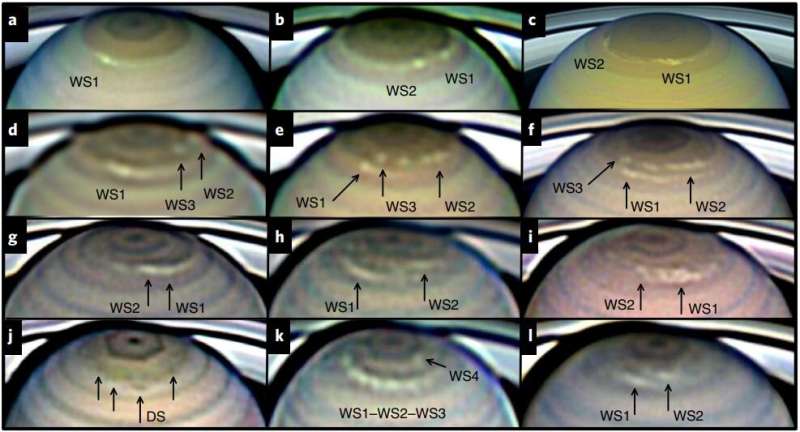October 22, 2019 report
Mid-sized storms spotted on Saturn

An international team of researchers has found that mid-sized storms form near Saturn's northern pole. In their paper published in the journal Nature Astronomy, the group describes discovering four of the mid-sized storms near the planet's northern polar region last year and their study of them.
Up until now, it was known that two types of storms form on Saturn—small ones that average approximately 2,000 kilometers across and Great White Spots, which can grow to 10 times the size of small ones and have tails that completely circle the planet. The smaller storms tend to last just a few days, Great White Spots, on the other hand, can last for several months. Now, it appears that a third type of storm can form on the planet—mid-size storms.
The researchers report that four such storms were spotted last year—all of them were several thousand kilometers across and all formed in the northern polar region of the planet. They differed dramatically in duration, however—from just a week and a half to seven months. Prior research has shown that storms on Saturn get their start in lower clouds far below the planet's upper cloud cover.
To learn more about the four mid-sized storms, the researchers studied imagery and data from a variety of sources, including amateur astronomers. Other sources included images from Hubble and the Calar Alto Observatory. They report that the storms formed over the course of eight months, from March to October of last year. Each showed up as small bright spots on images of the planet. The researchers also created models of the storms and ran simulations, which showed the storms used on average 10 times as much energy as the smaller storms, but less than 100th of the energy of the Great White Spots. The researchers suggest it is possible the mid-size storms were failed large storms—the timing seems to fit. The huge white storms form approximately every 60 years.
The researchers plan to continue looking for more data regarding the storms—one thing they have yet to learn is how much lightning is generated by mid-size storms. Finding the answer to that question, they note, could determine if the mid-size storms are more like the small ones or the really big ones
More information: A. Sánchez-Lavega et al. A complex storm system in Saturn's north polar atmosphere in 2018, Nature Astronomy (2019). DOI: 10.1038/s41550-019-0914-9
Journal information: Nature Astronomy
© 2019 Science X Network



















